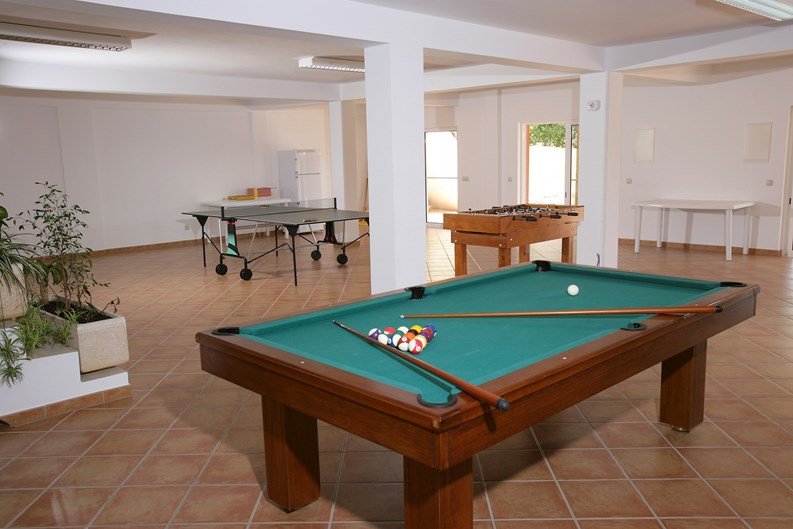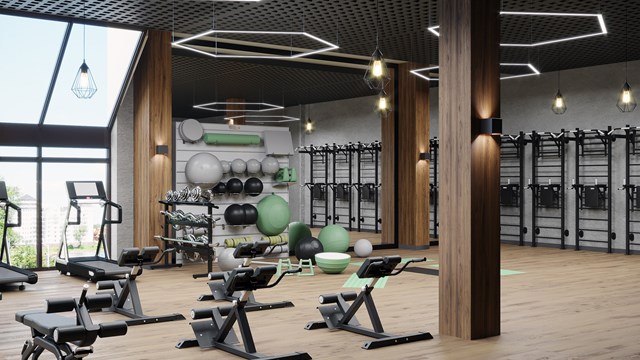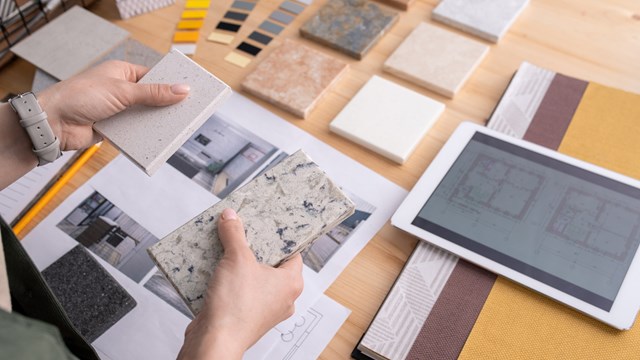In the past, developers would throw a few chairs and tables into a large room and call it a common area or a recreation room and leave it at that. Today, however, there’s more to designing, maintaining and upgrading a successful common area than just sweeping the floor and making sure the Nespresso machine is stocked with coffee pods. Over time, fitness centers, business centers, party rooms and movie theaters have been created for residents to enjoy, as tastes, technology and building demographics have changed.
“Association trustees wrestle with updating common areas,” says John Thiboutot, vice president at The Niles Co., Inc., in Canton, Massachusetts. “Generally, updating common areas is at the bottom of the list because repair /maintenance takes precedence over aesthetics. Trustees know that there is value in updating common areas—however, they are generally reluctant to increase fees or approve special assessments in order to get these types of projects done. Updating projects usually take years to do from original conception, and they get done when there is a lull in maintenance items.”
Even so, he notes, at some point, condominium owners may tire of their too-familiar surroundings and decide that it’s time to take the plunge. “I find that residents want a community they are proud of,” he notes. “When common areas are updated and clean, residents have a sense of pride about them. It also creates a welcoming environment for residents and their guests.”
Thiboutot cites the practical challenges—and the satisfaction—of getting a project off the ground and carried to completion. “I was involved in remodeling a common area entrance lobby to a building with 155 units. The renovation consisted of new tiles, carpeting, wall colors, lighting, and decorations. It was discussed for years, but other projects, such as a complete fire alarm replacement, took precedence over the renovation,” he recalls. “Finally, the decision was approved to start the project with a surplus from the previous year’s budget. It took a lot of coordination and communication because the main entrance could not be completely closed to traffic. The lobby took about two weeks to be completely transformed and the residents loved it. It gave a building that was built in the 1980s a modern feel and created some excitement in the building.”
Design Elements
Common areas in multifamily buildings and HOAs—particularly in denser urban areas where individual apartments may not exactly be spacious—“are often used as an extension of the residents’ home,” says Amy Courage, principal of DesignBar in Chicago, who has worked on the Ritz-Carlton Residences in Chicago which include a theater, billiard room and a wine lounge. “Today, owners are looking for social space, so the lounge space now has work tables where technology has been integrated. Before, the lounge space had been designed solely for watching TV, but now we provide work tables with plug-ins and comfortable chairs.”
Successful common areas include specific design elements that make the room aesthetically pleasing and functional—not only for current residents, but in a way that is attractive to new buyers as well. “A common area is successful if it is warm and welcoming and you feel like you’re home before you even get into your home,” says Gia Milazzo-Smith, founder of Designs by Gia Interior Designs in Princeton, Massachusetts. “They should have warm, inviting colors that are soothing and uncluttered furnishings that can be used by everyone.”
Designers say that a successful common area starts from the outside in. “You have to start from the exterior,” explains Wendell Gooch, a principal with Gooch Design Studio LLC in Chicago. “How the building vestibule is presented, the curb appeal of the exterior, the canopy, if it’s well lit, if you have a plant program and walk-off mats—it’s all part of a successful common room.”
Next, it’s important to get to know your residents and what they want in their common room. “The industrial loft aesthetic often sought by millennials has been making inroads into common areas, even in luxury buildings that typically cater to an older, more affluent demographic,” says Manhattan-based architect Richard J. DeMarco. He explains that in luxury properties, common areas generally reflect the status aspirations and entertainment needs of residents by offering high-end finishes and impressive views from top-floor and rooftop locations. “These design solutions allow residents to share the dramatic features of their residences when they host social functions,” he says.
If, say, a building’s residents include more families with children, parents would probably enjoy having a common area that is a children’s play area located close or next to the laundry room. In properties where there is a mix of single residents and families, a gym could provide a section for adults, but also a section with windows looking into the children’s playroom.
Designer Robin Wilson, author of the book Clean Design: Wellness for Your Lifestyle, says that common elements should include comfortable/durable /easily cleaned seating, non-slip flooring and layers of lighting (sconces, overhead and lamps or task lighting). “Lounges, media and play rooms should include televisions, wifi routers, seating for all ages, easily cleaned seating and flooring, storage for items with locks if appropriate for remotes, coffee supplies and toy bins. Lobbies should feature a simple layout with seating that can be rearranged, with warm, welcoming lighting and easily-cleaned flooring options,” says Wilson, who is also founder and CEO of Robin Wilson Home in New York City.
Successful design all about flexibility, too. “Put a pool table in the room, but make sure there are flexible seating arrangements so residents can make changes depending on what kind of event they are holding,” says Milazzo-Smith.
Fun in, Sound Out
Designers are also looking beyond the comfort of those using the common areas to the comfort of residents who occupy spaces nearby. To that end, they are using cork floors, which mitigate both the echo from conversations as well as the transfer of vibrations to spaces located below the floors. New ceiling systems, such as spray-on acoustical finishes, are also becoming increasingly popular, according to design professionals.
Energy efficiency is another important aspect of new materials and systems. “LED lighting fixtures, which are highly efficient and reduce maintenance costs, are currently very popular,” says DeMarco. “Especially since their initial cost has fallen down significantly in recent years.”
In updating a common area, it’s important to recognize the importance of windows and appropriate window treatments, the pros stress. Many Boston condo buildings offer fantastic views of the city, and if a common room isn’t getting the use it deserves, it may be that the room design doesn’t take advantage of the windows. The design process should also involve creating out-of-the-box solutions. “For example, the current design trends call for airy spaces with plenty of natural light,” says DeMarco. “When approaching a redesign of a common area located in a cellar without windows, a creative designer should still be able to incorporate this trend – maybe by including faux clerestory windows (windows located below ceilings) that imitate natural light.”
Outdoor common areas, particularly those that offer views from rooftops, continue to be highly valued and desired by residents in urban environments such as Boston, New York, and Chicago. Also gaining popularity for these rooftop spaces, designers say, are water elements like pools and Jacuzzis. The Macallen Building in Boston, for example, boasts a rooftop pool, along with green space and barbeques.
Common Room Blunders
Unfortunately, not all designers and developers know what it takes to make a common room that will be frequently used by its residents. “Design blunders and errors are typically related to misunderstanding the lifestyles of residents, layouts that impede traffic patterns and desired usage, and ineffective acoustical engineering.” Says DeMarco. “One of the most frequent design errors is either a lack of, or insufficient, warm-up kitchens. This makes it hard for residents to properly organize catered events.”
In some buildings, the common areas simply seem to stand out like a sore thumb compared to the rest of the building. If your building’s common rooms leave a little to be desired, the board should consider working with designers and architects who can provide adequate solutions. “When we get a call by someone appointed to the board, we have a meeting and first discuss the budget, the residents’ needs and the limitations of the space,” says Milazzo-Smith. “Then, once we have a complete presentation with our design ideas, we get it to the board and then wait for their decision.”
Designers approaching a new project or a renovation first perform a diligent analysis of the demographics in the building (who lives there?), usage patterns, efficiencies, inefficiencies, and the desired functions of common areas. “The feedback from HOA, individual residents, and building management is crucial in the pre-design phase,” says DeMarco.
The bottom line, Thiboutot says, is that “residents are looking for a clean, safe, modern place to come home to.” With that in mind, he adds, “Security cameras are an item presently considered in a lot of the common areas, as well as increased lighting. Some have considered electronic communication boards that can update and inform residents of particular items of interest at the association.”
Turning to the experts for advice is vital during the design process. Property managers and board members may have an idea of what they want, but don’t always know how to turn those dreams into reality. “The higher the quality of people they employ to design the room, the better it is for them,” Gooch says. “Engineers are going to care for the materials and put together a bid package and ask what the objectives are. The condo boards often have no idea how much things cost, so we put together a reserve study and price out all of the items that should be included. It helps them to say yes, or we need to wait a year and go back and raise the money.”
Lisa Iannucci is a freelance writer and a frequent contributor to New England Condominium. Associate Editor Pat Gale contributed to this article.







Leave a Comment